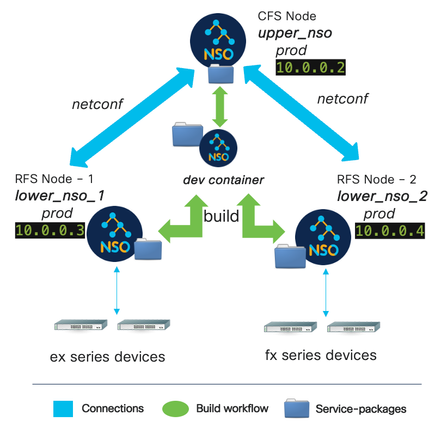
- Subscribe to RSS Feed
- Mark as New
- Mark as Read
- Bookmark
- Subscribe
- Printer Friendly Page
- Report Inappropriate Content
Introduction
Layered Service Architecture (LSA) is a design approach for massively large and scalable NSO applications. By using LSA with Containerized NSO, offers following benefits:
- Containerized NSO’s ability to isolate development and production environments, allowing customers to keep build essentials and dependencies from production environment, decluttering it of resource hogging build processes, while having separate container to take care of service code lifecycle.
- LSA based logical division of a service deployment, helping one to manage service design easily and troubleshoot or re-design specific parts of the code in service layer, when used with Containerized NSO helps both in deployment, and making maintenance easier for service package developers.
Within Containerized NSO Cisco is offering two types of docker images:
- Production - Production is solely used to run NSO instance with built service packages.
- Development - Development container packs only build essentials like Linux packages used only during building process of services, thus freeing up production from lifecycle activities.
In this tutorial, we will look at the example approach to setup LSA with Containerized NSO images. The setup used in this example is based on diagram below:
From diagram above, we have one CFS, and two RFS node, built from production container image. The packages used by all production containers is shared by development container where their lifecycle is managed.
Video Tutorial
Thanks to Escalation Team Manager Balaji Subramanian for helping out on introduction part
Code Example
- Gitlab: https://gitlab.com/nso-developer/lsa-container-example
- GitHub: https://github.com/NSO-developer/lsa-container-example
Forked from https://github.com/NSO-developer/ha-container-example by @Qi Li
Other example with HA-RAFT: https://github.com/NSO-developer/haraft-container-example
You must be a registered user to add a comment. If you've already registered, sign in. Otherwise, register and sign in.



